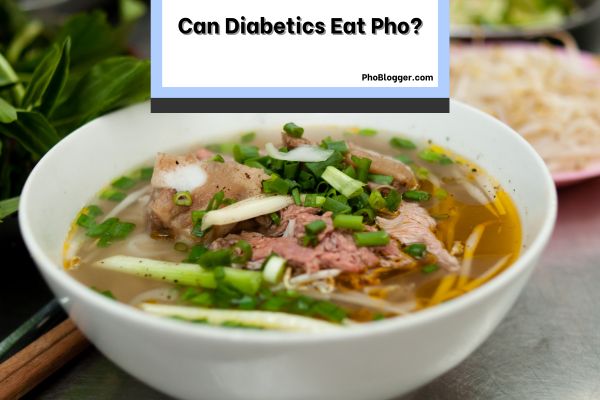Can diabetics eat pho? Before getting started – we’d like to remind you that you should always consult with your doctor. With that in mind, let’s continue.
Navigating dietary choices can be a bit of a challenge when you’re managing diabetes, as you have to balance your intake of carbohydrates, proteins, and fats while keeping an eye on your blood sugar levels.
Pho, a popular Vietnamese soup consisting of broth, rice noodles, herbs, and meat, might be one of the foods you’re wondering about.
In this comprehensive guide, we’ll discuss whether pho is suitable for a diabetic diet, its nutritional profile, and tips for making pho more diabetes-friendly.
Before you scroll further down this article, “Can Diabetics Eat Pho,” you can check out these other pho-related questions answered by our team at PhoBlogger.com:
Is Pho Suitable for Diabetics?
In its traditional form, pho can be a moderately balanced meal that could be incorporated into a diabetic diet, provided portion size and additional ingredients are carefully monitored.
Pho contains a variety of components, each with different nutritional values that can impact blood sugar levels:
- Rice noodles: The rice noodles in pho are high in carbohydrates, which can spike blood sugar levels if consumed in large amounts. However, they are low in fat and provide a source of energy.
- Meat: Pho often contains lean cuts of meat or chicken, providing protein that can help balance blood sugar levels.
- Broth: The broth, typically made from bone or meat stock, contributes to the soup’s overall flavor and adds minimal carbohydrates.
- Herbs and vegetables: Fresh herbs and vegetables often garnish pho, adding vitamins, minerals, and fiber, which can help slow the absorption of glucose into the bloodstream.
Nutritional Profile of Pho
The exact nutritional profile of pho can vary widely depending on the ingredients and portion size. A standard serving of pho may contain anywhere from 45-75 grams of carbohydrates, 20-30 grams of protein, and 5-15 grams of fat. The sodium content can be quite high due to the broth, and the fiber content is typically low unless additional vegetables are added.
Making Pho More Diabetes-Friendly
While pho can be a part of a balanced diabetic diet, there are ways to make it even more suitable for managing blood sugar levels:
- Watch the portion size: The serving size is crucial when it comes to the carbohydrate content. A smaller portion of noodles can help control carbohydrate intake and thus manage blood sugar levels more effectively.
- Load up on non-starchy vegetables: Adding more non-starchy vegetables, such as bean sprouts, lettuce, or other greens, can increase the fiber content of the dish, slow glucose absorption, and make you feel fuller without adding many extra carbs.
- Opt for lean proteins: Choosing lean cuts of meat, chicken, or tofu can provide you with necessary protein without adding extra fats.
- Limit sauces and condiments: Sauces like hoisin or sriracha can add extra sugar and carbohydrates. Use these sparingly or not at all.
- Choose lower-sodium options: If possible, opt for pho made with lower-sodium broth to manage your sodium intake.
Frequently Asked Questions
Can diabetics eat pho for breakfast?
Yes, diabetics can eat pho for breakfast as long as they keep an eye on portion sizes and the balance of ingredients. Remember, the goal is to manage carbohydrate intake to prevent blood sugar spikes.
Can diabetics eat vegetarian pho?
Yes, vegetarian pho can be a good option for diabetics, especially if it contains plenty of non-starchy vegetables and tofu for protein. However, keep an eye on the noodle portion to manage carbohydrate intake.
Can I eat pho if I have gestational diabetes?
Yes, you can eat pho if you have gestational diabetes. The same principles apply—watch your portion size, especially of noodles, and add plenty of non-starchy vegetables. Always consult with your healthcare provider or a dietitian for personalized advice.
How often can diabetics eat pho?
The frequency with which a person with diabetes can eat pho depends on their overall diet plan, carbohydrate goals, and how well they’re able to manage their blood sugar levels. It’s always best to consult with a healthcare provider or dietitian for personalized advice.
Conclusion For “Can Diabetics Eat Pho”
Pho can be included in a diabetic diet with some modifications and careful consideration of portion sizes and ingredients. The key to managing diabetes is maintaining a balanced diet that allows for the enjoyment of a variety of foods while keeping blood glucose levels in check.
And remember, individual responses to different foods can vary, so it’s a good idea to monitor your blood sugar levels before and after meals to understand how different foods and portions affect you.
If you’re unsure about incorporating pho into your diet or have questions about managing your diabetes, it’s always best to consult with a healthcare provider or a registered dietitian. They can provide personalized advice based on your health status, lifestyle, and dietary needs.
In the end, eating with diabetes doesn’t have to be boring or restrictive. It’s about making mindful choices that satisfy your palate while also keeping your health in check. With some careful planning and knowledge, you can enjoy a wide range of foods, including a comforting and delicious bowl of pho.
If you find this article, “Can Diabetics Eat Pho,” helpful/informative, you can check out these other pho-related content from our team at PhoBlogger.com:
- Can I Eat Bean Sprouts in Pho While Pregnant?
- Where to Buy Beef Tendon For Pho?
- Does Pho Have Peanuts?
You can learn more about pho and what’s in this popular Vietnamese noodle soup by watching “The Best Vietnamese Pho Recipe” from Quang Tran down below:

